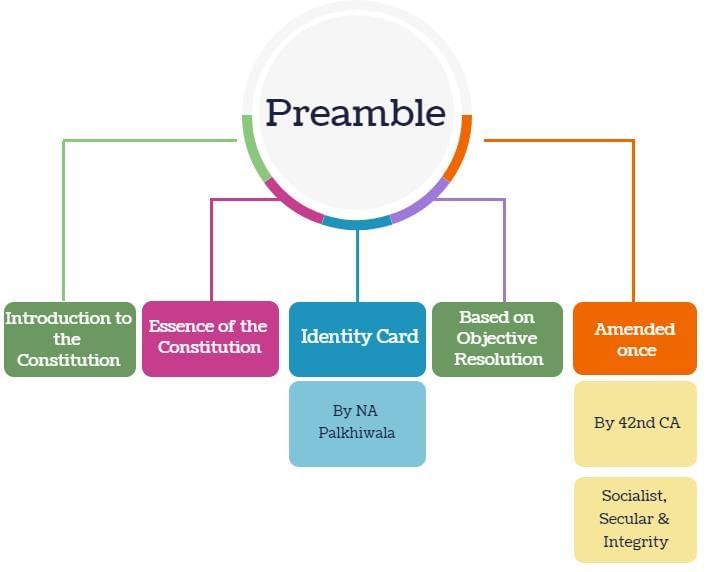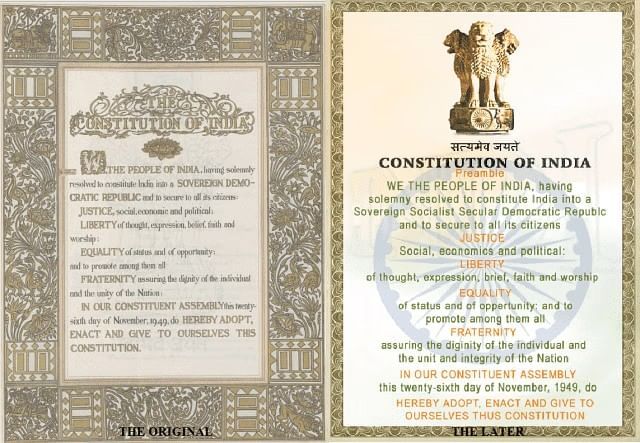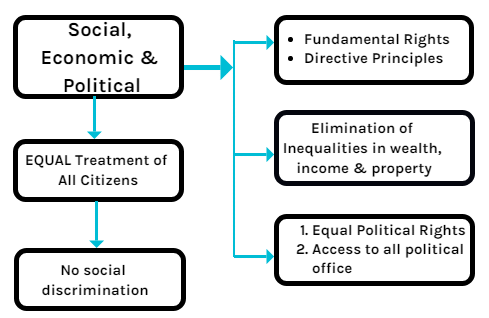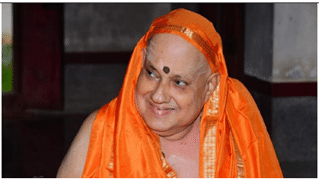- India shall be a Union of erstwhile British Indian territories, Indian States, and other parts outside British India and the Indian States as are willing to be a part of the Union.
- All these regions will have some independence in their own matters, except those under the central government.
- The government will get its power from the people.
- Every Indian will get justice — social, economic, and political.
- There will be equality in status, chances, and legal rights.
- People will enjoy freedom of speech, belief, religion, work, and association within legal and moral limits.
- Special protection will be given to minorities, tribes, and weaker sections.
- India's unity and independence on land, sea, and air will be protected as per law.
- India will work to regain its global respect and promote peace and human welfare.
Introduction: Preamble | Indian Polity for UPSC CSE PDF Download
The Preamble of the Indian Constitution
The Constitution of India is the longest written constitution in the world. It is the bedrock of all of the Indian polity. The Preamble is a brief introductory statement to the Constitution of India. It constitutes the philosophy embodying the ideals and aspirations to which the national movement was committed. The Preamble can be referred to as the preface, which highlights the entire Constitution.

Significance of the Preamble
The Supreme Court has affirmed in various judgments that the Preamble forms an integral part of the Constitution. The opening and concluding words, “We, the people…adopt, enact, and give to ourselves this Constitution,” emphasise that sovereignty lies with the people of India. This makes the Preamble the very soul of the Constitution.
K.M. Munshi aptly called the Preamble the Horoscope of the Constitution as it forecasts the nature of the Indian state post-independence.

Historical Background of the Preamble to Indian Constitution
The journey of the Preamble began with the Objective Resolution, introduced by Jawaharlal Nehru on December 13, 1946, in the Constituent Assembly. This resolution laid the groundwork for the core principles and objectives that would guide the drafting of the Constitution.
Key Points of the Objective Resolution
Drafting of the Preamble
B.N. Rao drafted an initial version of the Preamble, stating, “We, the people of India, seeking to promote the common good, do hereby, through our chosen representatives, enact, adopt and give to ourselves this constitution.” This draft was presented to the Constituent Assembly on July 4, 1947.
Final Adoption
After extensive debates and refinements, the Preamble was formally adopted by the Constituent Assembly on Nov 26, 1949.
Did You Know ?
- The Preamble was designed by Beohar Rammanohar Sinha, a famous artist from Jabalpur
- The original handwritten copies of the Constitution were written by Prem Behari Narain Raizada.
- The date of adoption of the Constitution 26 November 1949, is clearly mentioned in the Preamble.
- Article 394 includes all the Articles that came into effect on 26 November 1949.
Key Concepts of the Preamble of the Indian Constitution
The Preamble of the Indian Constitution highlights the core values and goals of the nation. It describes India as a sovereign, socialist, secular, and democratic republic, and ensures justice, liberty, equality, and fraternity for all. These values form the foundation of our Constitution and guide the way India is governed, showing the country’s strong commitment to fairness, freedom, and unity for everyone.
Sovereign
- Implies that the Indian state has sole authority to make decisions on both internal and external issues.
- No foreign power can impose its will on the Indian government.
- India is a sovereign nation, not a colony or a dependency on another country.
- India is a supreme power, and no internal or external forces can challenge the authority of the Indian government.
- As a sovereign state, India is immune to foreign interference in its domestic affairs.
Socialist
- The word "Socialist" was added to the Preamble by the 42nd Amendment in 1976 to show India's commitment to social and economic equality.
- The government is responsible for ensuring fair distribution of resources among all citizens.
- It also works to provide basic needs and services to everyone, no matter their social or economic background.
- This idea of socialism is also reflected in the Directive Principles of State Policy (DPSPs) in the Constitution.
Secular
- Embodies the optimistic notion that all religions in India enjoy the same status and support from the government.
- Emphasizes India's constitutional secularism and lack of an official religion.
- The State must respect and embrace all religions rather than favour or patronize any one of them.
- The term "Secular" was added to the Preamble by the 42nd Constitutional Amendment in 1976.
Democracy
- It implies an established form of Constitution which gets its authority from the will of the people expressed in an election.
- Establishes a representative parliamentary democracy where the executive is accountable to the legislature for all policies and actions.
- However, the term Democratic is a broad concept. In the Preamble, it means not just political democracy but social and economic democracy as well.
Republic
- It implies the head of the Indian state, the President, is elected by the people and all the offices including that of the President is open to all citizens.
- India became independent in 1947 as a Dominion within the British Commonwealth; however, in 1950 following the adoption of the Constitution India became a Republic.
Justice
- Justice in the Preamble includes social, economic, and political aspects, ensuring fairness in every sphere of life
- Seeks to abolish discrimination based on birth, caste, colour, sex, or religion.
- Ensures equitable access to public opportunities and aims for the common good of all citizens.
- Inspired by the Russian Revolution (1917).
 Meaning of Justice as per the Constitution
Meaning of Justice as per the Constitution
Liberty
- Liberty refers to freedom of thought, expression, belief, faith, and worship
- This establishes that there are no unreasonable restrictions on Indian citizens in terms of what they think, their manner of expression and the way they wish to follow up their thoughts in action.
- These are enshrined in the Constitution under the chapter on Fundamental Rights.
- However, liberty does not mean freedom to do anything, and it must be exercised within the constitutional limits.
- It is inspired by the French Revolution (1789–1799).
Equality
- Rights are meaningless without removing social inequalities and ensuring equality of status and opportunity.
- Equality of status is ensured by prohibiting discrimination on religion, race, sex, colour, place of residence, etc.
- It is strengthened by abolishing untouchability and titles.
- Equality of opportunity is guaranteed through the rule of law that is equality before law and no discrimination in public jobs.
- Political equality is achieved through universal adult franchise.
- It is inspired by the French Revolution (1789–1799).
Fraternity
- Refers to a sense of brotherhood and sisterhood among citizens and a sense of belonging to the country.
- Ensures human dignity, national unity, and integrity.
- Aims to overcome communalism, regionalism, casteism, linguism, secessionism, and other threats to national integration.
- The word "integrity" was added to the Preamble by the 42nd Constitutional Amendment (1976).
Preamble’s Relation with the Constitution
The role of the Preamble in the Indian Constitution has been the centre of important legal debates and decisions. Here's a breakdown of how its status has evolved through key court cases:
AK Gopalan Case (1950)
- The Supreme Court held that the Preamble was not enforceable as it wasn’t considered part of the Indian Constitution.
Berubari Union Case (1960)
- The Supreme Court initially stated that the Preamble is not a part of the Constitution.
- It was considered merely an introduction and could not be used to interpret the Constitution’s provisions, drawing from American legal perspectives where the Preamble is seen as an introductory statement only.
Kesavananda Bharati Case (1973)
- This landmark decision reversed the previous stance from the Berubari Union Case.
- The Supreme Court declared the Preamble as an integral part of the Constitution.
- Although it does not grant any powers by itself, the Preamble is crucial for interpreting the Constitution's articles and clauses.
- The Court emphasized that the Preamble forms part of the Constitution’s "basic structure," a concept that means its essential elements cannot be amended or removed.
 Kesavananda Bharati
Kesavananda Bharati
LIC of India Case (1995)
- The Court reaffirmed that the Preamble is a core part of the Constitution.
- However, it clarified that the Preamble itself does not have standalone enforceability in court.
Amendability of the Preamble
The legal question of whether the Preamble is amendable, given its non-justiciable nature, has been interpreted differently by the Supreme Court in two significant cases:
Berubari Union Case (1960):
- The Supreme Court held that despite being the key to the minds of the Constitution makers, the Preamble is not a part of the Constitution.
- Therefore, it cannot be amended.
Kesavananda Bharati Case (1973):
- The Supreme Court rejected the earlier judgement in the Berubari Case.
- It held that the Preamble is a part of the Constitution and can be amended.
- The Preamble was amended only once in 1976 by the 42nd Constitutional Amendment Act, which added three new words: Socialist, Secular, and Integrity.
42nd Amendment to the Constitution
The 42nd Amendment made the following changes to the Preamble:
- Description of India: Changed from “sovereign democratic republic” to “sovereign, socialist, secular democratic republic.”
- Unity of the Nation: Changed the words “unity of the nation” to “unity and integrity of the nation.”
Conclusion
- The Preamble of the Indian Constitution outlines the fundamental principles and objectives of the Constitution. It reflects the aspirations of the people of India and the values the Constitution seeks to uphold.
- Each key concept outlined in the Preamble is significant for Indian society and governance. The principles of sovereignty, socialism, secularism, democracy, justice, liberty, equality, and fraternity form the bedrock of the Indian Constitution and guide the country’s political, social, and economic development.
- The Preamble provides a roadmap for achieving these objectives and provides inspiration and guidance for all Citizens of India.
|
170 videos|999 docs|259 tests
|
FAQs on Introduction: Preamble - Indian Polity for UPSC CSE
| 1. What is the significance of the Preamble in the Indian Constitution? |  |
| 2. How did historical events influence the creation of the Preamble of the Indian Constitution? |  |
| 3. What are the key concepts enshrined in the Preamble of the Indian Constitution? |  |
| 4. Is the Preamble of the Indian Constitution amendable? |  |
| 5. How does the Preamble relate to the rest of the Indian Constitution? |  |

















